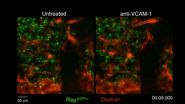The DAPT Study assessed the benefits of 12 versus 30 months of dual antiplatelet therapy for preventing stent thrombosis and major adverse cardiovascular and cerebrovascular events (MACCE; composite of death, heart attack or stroke) in subjects undergoing percutaneous coronary intervention (PCI) with drug-eluting stent (DES) placement for the treatment of coronary artery lesions. While clotting inside the stent or in other blood vessels may occur after one year, the benefit of continuing treatment was unknown. The DAPT Study was performed as a public-private partnership in response to a request from the United States Food and Drug Administration (FDA) to the manufacturers of FDA-approved coronary stents to examine this important public health question in a broadly-inclusive and well-powered study.
Laura Mauri, M.D., M.Sc., principal investigator of the DAPT Study, interventional cardiologist at the Brigham and Women's Hospital, Associate Professor of Medicine at Harvard Medical School and Chief Scientific Advisor for HCRI, will present these results in a late-breaking clinical trial session at the American Heart Association (AHA) Scientific Sessions 2014 in Chicago, and the results will be published simultaneously in the New England Journal of Medicine1. The findings from a secondary analysis of subjects who were treated with bare metal stents (BMS) will be presented by Dean J. Kereiakes, M.D., the DAPT Study co-principal investigator, Medical Director of The Christ Hospital Heart and Vascular Center and The Carl and Edyth Lindner Center for Research and Education at The Christ Hospital, Cincinnati, Ohio, on Tuesday, November 18, 2014, at 4:51 p.m. CT. Information regarding additional AHA presentations and publications related to the DAPT Study may be found at http://www.DAPTStudy.org.
"The benefits of continuing dual antiplatelet therapy for 30 months were quite remarkable. The relative risk of a stent-related blood clot was reduced by 71%, compared with taking only aspirin after one year. The DAPT Study was the first and only study that was adequately powered to detect this benefit. Furthermore, the relative risk of heart attack was reduced by 53% by preventing these stent-related events, as well as by preventing events in vessels beyond the stented lesion," said Dr. Mauri. "The study is a result of unprecedented collaboration amongst industry, government and academia, and valuable contributions from the investigators and patients."
"The benefits with extended treatment were present across all stent and drug types included in the study. Additionally, the results were consistent regardless of patient characteristics, such as whether the stent was placed during a heart attack or whether the procedure was technically simple or complex.
"We believe that the overall benefits of continuing dual antiplatelet therapy to at least 30 months after treatment with drug-eluting stents outweigh the bleeding risks in patients without a history of major bleeding, and these results may warrant a shift in clinical practice. Our observations from a secondary analysis suggest that continued dual antiplatelet therapy beyond one year may be beneficial in patients treated with bare metal stents, but further study is required to discern if these patients derive equal benefit," said Dr. Kereiakes.
In an additional secondary analysis extending to 33 months, all-cause mortality was noted to be higher with nominal significance for the extended treatment group, driven by an increase in non-cardiovascular deaths. This observation prompted an in-depth, blinded adjudication of non-cardiovascular causes of death and an independent meta-analysis of prior randomized trials was performed by the study investigators. The findings of the meta-analysis will be published in a manuscript authored by Robert Yeh, M.D., M.Sc., investigator of the DAPT Study, interventional cardiologist at Massachusetts General Hospital, Assistant Professor of Medicine at Harvard Medical School and Medical Director of Trial Design for HCRI, et al., in The Lancet, and released concurrently with the late-breaking clinical trial session at AHA2.
Dr. Mauri commented, "While we don't discount the observations regarding non-cardiovascular mortality, the findings of our additional analyses and adjudication were reassuring. The blinded adjudication revealed that among patients whose death was related to cancer, more patients with known cancer prior to enrollment were randomized into the 30-month study group rather than into the placebo group. Taken together with the fact that a meta-analysis of over 60,000 patients enrolled in prior large randomized studies comparing longer-term thienopyridine treatment to placebo showed no difference in mortality, it is possible that the mortality finding was related to a chance imbalance between the groups studied in the trial."
DAPT Study Protocol The American College of Cardiology and American Heart Association currently recommend at least 12 months of dual antiplatelet therapy for subjects undergoing percutaneous coronary intervention (PCI) following placement of a drug-eluting stent (DES). The DAPT Study was a prospective, randomized, double-blind trial that evaluated subjects treated with DES or a bare metal stent (BMS) at 452 centers in 11 countries. A total of 25,682 subjects were enrolled into the DAPT Study by HCRI and from four participating stent manufacturer-sponsored studies that each followed the DAPT Study protocol3.
The primary analysis involved the 12-30 month treatment period for the DES-treated cohort, which comprised 22,866 DES subjects who received 12 months of open-label thienopyridine/antiplatelet treatment in addition to aspirin. After 12 months, a total of 9,961 subjects who were free from all MACCE or major bleeding events and were compliant with thienopyridine treatment were randomized 1:1 to either placebo (N=4,941) or ongoing dual antiplatelet therapy (N=5,020) for an additional 18 months, followed by three months of observational follow-up. Both arms continued aspirin therapy. The choice of stent type (from FDA-approved devices) and thienopyridine drug (clopidogrel or prasugrel) was at the discretion of the patient and physician.
DAPT Study Efficacy Findings Stent thrombosis (defined as definite/probable by the Academic Research Consortium) and major adverse cardiac and cerebrovascular events (MACCE; composite of mortality, myocardial infarction or stroke) over the primary analysis period were the co-primary effectiveness end points. Compared with subjects treated with dual antiplatelet therapy for 12 months, subjects randomized to 30 months of treatment had a significantly lower cumulative incidence of stent thrombosis (0.4% versus 1.4%, hazard ratio 0.29, P < 0.001) and of MACCE (4.3% versus 5.9%, hazard ratio 0.71, P < 0.001), which was driven by a reduction in myocardial infarction (2.1% versus 4.1%, hazard ratio 0.47, P < 0.001). Non-stent thrombosis-related myocardial infarction comprised 55% of the treatment benefit (1.8% versus 2.9%, hazard ratio 0.59, P < 0.001). The incidence of stroke was similar between the two treatment arms (0.8% versus 0.9%, P = 0.32).
In the secondary analysis comparing the rates of stent thrombosis and MACCE for DES- versus BMS-treated subjects, subjects with DES had significantly lower rates of stent thrombosis and non-inferior major adverse cardiac event rates, compared with BMS, through 33 months of follow up. The treatment benefit effect (reduced stent thrombosis events) of 30 months of dual antiplatelet therapy (versus 12 months) in BMS-treated subjects was consistent with that observed in the DES-treated subjects, but further study is required to discern if BMS-treated subjects derive equal benefit. In the BMS group, bleeding events with extended therapy followed a similar trend as that seen in the primary analysis of DES subjects, where bleeding rates were higher but bleeding was rarely severe or fatal. Additional details from this analysis are embargoed until 4:51 p.m. CT on November 18, 2014.
DAPT Study Safety Findings The incidence of moderate or severe bleeding (by Global Utilization of Streptokinase and TPA for Occluded arteries, classification) was the primary safety endpoint and was significantly higher in subjects that received 30 months of dual antiplatelet therapy (2.5% versus 1.6%, hazard ratio 1.61, P = 0.001), and did not meet the pre-specified definition of non-inferiority. Cases of severe or fatal bleeding, or intracranial hemorrhage were rare and did not differ significantly between the two arms. An increased risk of stent- and non-stent-related myocardial infarction was detected in the three-month period following discontinuation of active therapy in both treatment arms. Over the primary analysis period, cardiac mortality (0.9% versus 1.0%, P = 0.98) and vascular mortality (0.1% versus 0.1%, P = 0.98) were similar across the two arms, and all-cause mortality was 2.0% versus 1.5% (hazard ratio 1.36, P = 0.05).
In a secondary analysis that included the final follow-up time point of 33 months, all-cause mortality was 2.3% in the 30-month arm versus 1.8% in the 12-month arm (hazard ratio 1.36, P = 0.04). The higher mortality in the 30-month arm was driven by a higher rate of non-cardiovascular death. The observed difference in non-cardiovascular mortality was not entirely accounted for by differences in bleeding. While there was no difference between the study arms in new cancer occurrences reported over the course of the study, there were 22 more subjects with cancer at baseline in the continued treatment arm, and cancer-related deaths were 31 versus 14, P = 0.02. A blinded review of cancer-related deaths identified an imbalance in the longer-term treatment arm (8 subjects versus 1 subject in the placebo arm with the diagnosis of the cancer that led to death detected prior to enrollment in subjects that were subsequently randomized). When these subjects were excluded in a post hoc sensitivity analysis, the differences in mortality between the two study arms were no longer significant.
INFORMATION:
About the DAPT Study Collaboration
The DAPT Study was conducted by the Harvard Clinical Research Institute (HCRI) through a public-private collaboration involving HCRI; four major stent manufacturers: Abbott (XIENCE V®), Boston Scientific Corporation (TAXUS®, PROMUS®), Cordis Corporation (CYPHER®) and Medtronic, Inc. (Endeavor®); the manufacturers of thienopyridine/antiplatelet medications: Bristol-Myers Squibb Company/Sanofi Pharmaceuticals Partnership (Plavix® (clopidogrel bisulfate)) and Eli Lilly and Company and Daiichi Sankyo Company, Limited (Effient/Efient® (prasugrel)); and the U.S. Food and Drug Administration (FDA). HCRI, which was responsible for the scientific and operational management of the DAPT Study and the independent analysis of the resulting data, received funding support from each of the drug and device manufacturers, the FDA and a grant from the U.S. Department of Health and Human Services.
More information about the DAPT Study is available at http://www.DAPTStudy.org.
About The Harvard Clinical Research Institute (HCRI)
The Harvard Clinical Research Institute (HCRI) is a non-profit academic research organization with unparalleled access to resources in clinical research. The Institute advances the research of pharmaceutical, biological and medical device products by developing collaborations between industry and academia. HCRI's partners include leading medical centers with worldwide recognition for high-quality medical care and state-of-the-art facilities. Its close affiliation with Harvard Medical School, Beth Israel Deaconess Medical Center and Partners HealthCare reinforces HCRI's commitment to engaging distinguished medical practitioners in thought-provoking, industry-sponsored research. The Institute's sponsors rely on its scientific objectivity to add unique value to the design of their studies, oversight of their research and analysis of their study data. As a leading provider of clinical trial services, HCRI plays an important role in assessing new products that improve the quality of peoples' lives. http://www.hcri.harvard.edu
Concurrently Published Manuscripts Associated with the DAPT Study
1Mauri L, Kereiakes DJ, Yeh RW, et al. Twelve or 30 Months of Dual Antiplatelet Therapy After Drug-eluting Stents. New England Journal of Medicine. Online ahead of print November 16, 2014.
2Elmariah S, Mauri L, Doros G, et al. Extended Duration Dual Antiplatelet Therapy and Mortality: A Systematic Review and Meta-analysis. The Lancet. Online ahead of print November 16, 2014.
3Stent Manufacturer-sponsored Studies Contributing to the DAPT Study, NCT00977938:
TAXUS Liberté Post Approval Study, Boston Scientific Corporation, NCT00997503
XIENCE V USA DAPT Cohort, Abbott, NCT01106534
EDUCATE, Medtronic, Inc., NCT01069003
CYPRESS, Cordis Corporation, NCT00954707
A note regarding registered trademarks:
CYPHER® is a registered trademark of Cordis Corporation
Endeavor® is a registered trademark of Medtronic, Inc.
TAXUS® and PROMUS® are registered trademarks of Boston Scientific Corporation
XIENCE V® is a registered trademark of Abbott
Effient/Efient® is a registered trademark of Eli Lilly and Company
Plavix® is a registered trademark of Sanofi-Aventis






